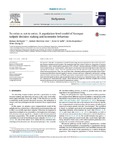To swim or not to swim: A population-level model of Xenopus tadpole decision making and locomotor behaviour.
| dc.contributor.author | Borisyuk, R | en |
| dc.contributor.author | Merrison-Hort, R | en |
| dc.contributor.author | Soffe, SR | en |
| dc.contributor.author | Koutsikou, S | en |
| dc.contributor.author | Li, W-C | en |
| dc.date.accessioned | 2018-03-27T10:24:14Z | |
| dc.date.issued | 2017-11 | en |
| dc.identifier.uri | http://hdl.handle.net/10026.1/11179 | |
| dc.description.abstract |
We present a detailed computational model of interacting neuronal populations that mimic the hatchling Xenopus tadpole nervous system. The model includes four sensory pathways, integrators of sensory information, and a central pattern generator (CPG) network. Sensory pathways of different modalities receive inputs from an "environment"; these inputs are then processed and integrated to select the most appropriate locomotor action. The CPG populations execute the selected action, generating output in motor neuron populations. Thus, the model describes a detailed and biologically plausible chain of information processing from external signals to sensors, sensory pathways, integration and decision-making, action selection and execution and finally, generation of appropriate motor activity and behaviour. We show how the model produces appropriate behaviours in response to a selected scenario, which consists of a sequence of "environmental" signals. These behaviours might be relatively complex due to noisy sensory pathways and the possibility of spontaneous actions. | en |
| dc.format.extent | 3 - 14 | en |
| dc.language | eng | en |
| dc.language.iso | eng | en |
| dc.subject | Central pattern generator | en |
| dc.subject | Sensory pathways | en |
| dc.subject | Struggling behaviour | en |
| dc.subject | Swimming behaviour | en |
| dc.subject | Wilson-Cowan model | en |
| dc.subject | Animals | en |
| dc.subject | Behavior, Animal | en |
| dc.subject | Decision Making | en |
| dc.subject | Larva | en |
| dc.subject | Locomotion | en |
| dc.subject | Models, Neurological | en |
| dc.subject | Motor Neurons | en |
| dc.subject | Nerve Net | en |
| dc.subject | Neural Inhibition | en |
| dc.subject | Swimming | en |
| dc.subject | Xenopus | en |
| dc.title | To swim or not to swim: A population-level model of Xenopus tadpole decision making and locomotor behaviour. | en |
| dc.type | Journal Article | |
| plymouth.author-url | https://www.ncbi.nlm.nih.gov/pubmed/28720508 | en |
| plymouth.volume | 161 | en |
| plymouth.publication-status | Published | en |
| plymouth.journal | Biosystems | en |
| dc.identifier.doi | 10.1016/j.biosystems.2017.07.004 | en |
| plymouth.organisational-group | /Plymouth | |
| plymouth.organisational-group | /Plymouth/Faculty of Science and Engineering | |
| plymouth.organisational-group | /Plymouth/REF 2021 Researchers by UoA | |
| plymouth.organisational-group | /Plymouth/REF 2021 Researchers by UoA/UoA11 Computer Science and Informatics | |
| plymouth.organisational-group | /Plymouth/Users by role | |
| plymouth.organisational-group | /Plymouth/Users by role/Researchers in ResearchFish submission | |
| dc.publisher.place | Ireland | en |
| dcterms.dateAccepted | 2017-07-10 | en |
| dc.identifier.eissn | 1872-8324 | en |
| dc.rights.embargoperiod | Not known | en |
| rioxxterms.versionofrecord | 10.1016/j.biosystems.2017.07.004 | en |
| rioxxterms.licenseref.uri | http://www.rioxx.net/licenses/all-rights-reserved | en |
| rioxxterms.licenseref.startdate | 2017-11 | en |
| rioxxterms.type | Journal Article/Review | en |
| plymouth.funder | Cross-modality integration of sensory signals leading to initiation of locomotion::BBSRC | en |
| plymouth.funder | Cross-modality integration of sensory signals leading to initiation of locomotion::BBSRC | en |
| plymouth.funder | Cross-modality integration of sensory signals leading to initiation of locomotion::BBSRC | en |


